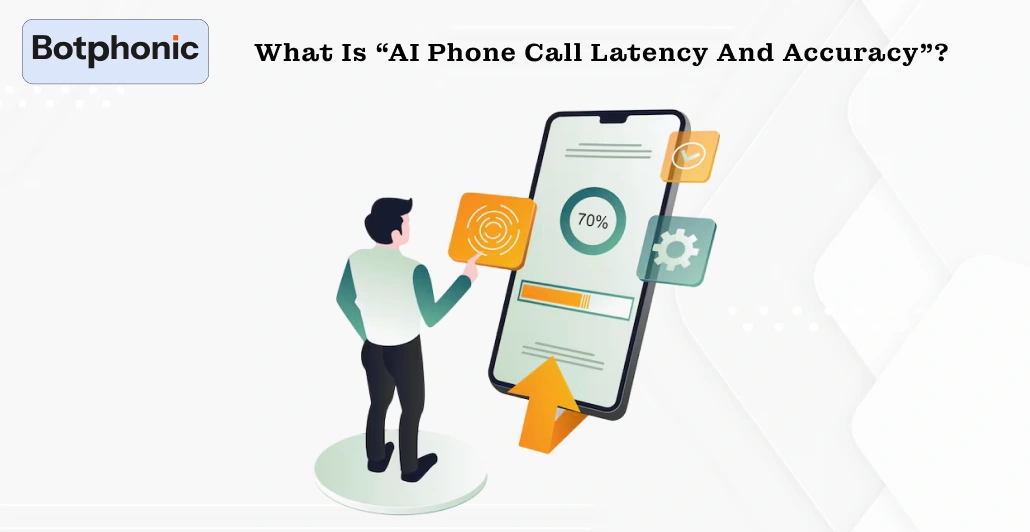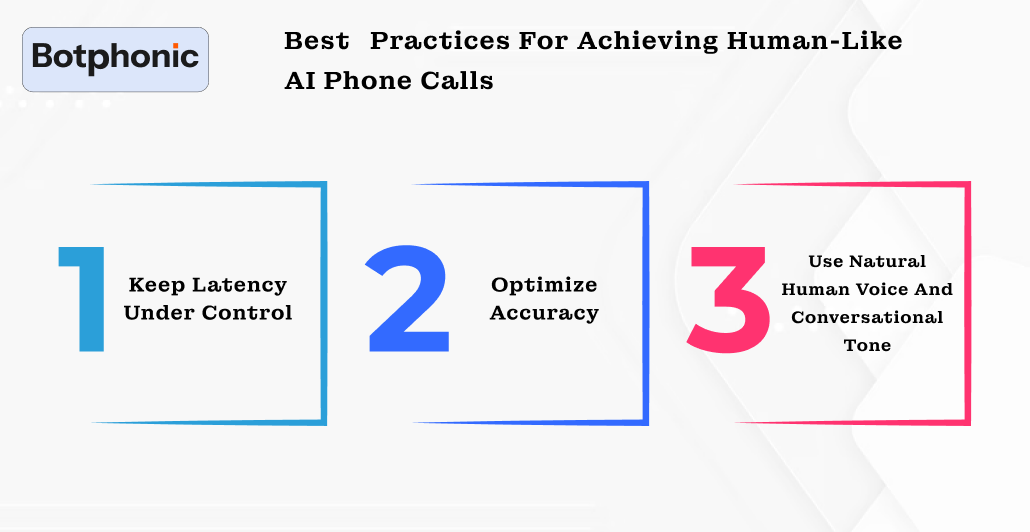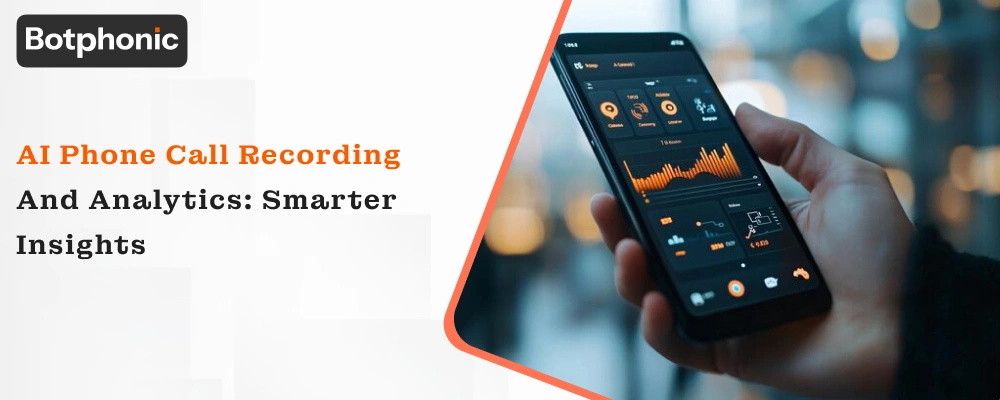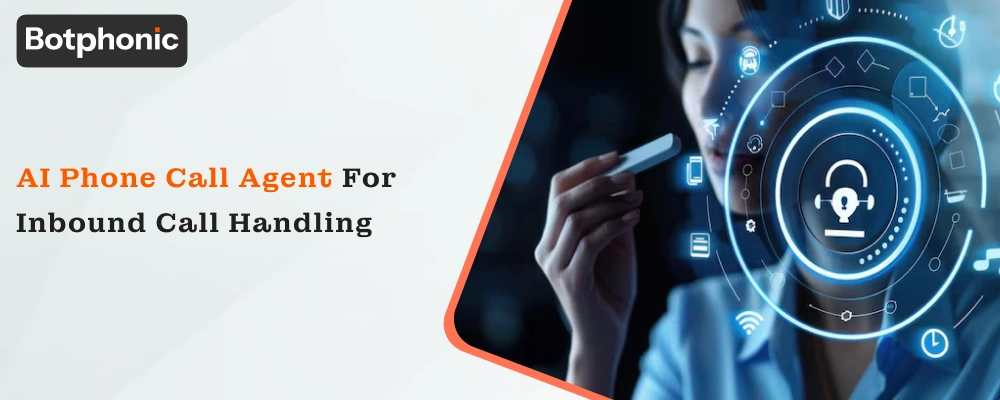
Summarize Content With:
Summary
The focus of this blog is to understand how AI phone calls can be so accurately human-like by concentrating on the two factors of AI phone call latency and accuracy. First, we will determine what response time is in an AI phone call. Next, we will find out why accuracy is extremely important. Lastly, we will see how a solution like Botphonic can use very advanced methods in order to achieve a near-human interaction with the customer.
Key Takeaways
- Low latency is necessary for a conversation to sound realistic; every additional second causes the user’s experience to deteriorate.
- The high accuracy of speech recognition, understanding, and response is the factor that makes AI phone calls appear to be human.
- AI call assistants (like Botphonic) integrate latency management, accuracy optimisation, and domain-specific training to perform activities such as delivering bookings, customer support, lead generation, and more.
- These AI voice systems-enabled businesses can not only extend their outreach efforts and automate booking as well as support tasks, but also do so at a level where the customers will not feel that they are interacting with a machine, thus their satisfaction will improve further.
Introduction
Imagine this: you call a company, and the person on the other side sounds so unbelievably normal that you almost forget that you are actually talking to a machine. The tone is nice, the answer is immediate, and the chat goes on without any kind of effort. That is exactly what artificial intelligence wants to come up with.
The use of an AI call assistant to answer, book, or follow up is a high-stakes game in today’s business world. The caller demands a quick, accurate and human-like experience. In case the call is prolonged and the delay is very noticeable, then the whole thing sounds very fake. When the answers are inaccurate or stiff, the trust of the interlocutor is lost.
Here, we are going to discuss how these systems face the problems of latency and accuracy and still provide communication that is indistinguishable from that with human beings. We consider Botphonic’s platform as a case study, investigate the underlying technology and best practices, show tables for comparison, and provide actionable tips.
If you were a company willing to use AI to automate booking or customer support calls, or if you were simply interested in the progress of AI in the voice sector, then this article would serve you well.
What is “AI phone call latency and accuracy”?

It is important to note that latency is the delay between the moment when the user speaks (or dials) and the AI system responds. The longer the pause or lag, the more the user of the system becomes aware that it is not a natural dialogue but stuck between the lines of tech.
Studies demonstrate that whenever the waiting time increases by one second, customer satisfaction is lowered by about 16%. Systems that are designed to feel natural and human-like aim for latency less than 1 second or, at the very least, less than 2 seconds.
Accuracy covers three major sub-areas: speech recognition (did the system correctly hear what the caller said?), understanding/intent (did it interpret correctly?), and response generation (did it reply appropriately and in a human tone?). If one of these components fails, the output is robotic and not natural.
An AI voice call assistant must strive to be both fast and accurate in order to simulate human-like dialogues. In case the response time is good but the system is inaccurate, the callers will receive incorrect answers and will thus be annoyed. Conversely, if the accuracy is high but the response time is long, the dialogue will be awkward and dragged..
Why does latency matter so much in AI phone calls?
Humans do not tolerate delays in their phone conversations very well. When the response of the other party takes 3 or 4 seconds, humans feel uncomfortable, and they assume it is a machine. Studies also support this notion: normal LLM systems with 3-4 seconds of delay make the conversation less human. For instance, one study says, “3-4 seconds of latency can completely ruin call quality.”
Why does latency degrade experience? The answer is that in natural conversation, the length of the very short pauses is only a few hundred milliseconds. Every additional delay is added to the previous one. For instance:
- Caller: “Hi, I’d like to schedule an appointment.”
- (Pause 3 seconds)
- Machine: “Sure, what time works for you?”
That pause is quite evident. The caller is holding, and the rhythm of human conversation is interrupted.
On the other hand, voice AI pipelines comprise several stages: recording audio, speech recognition (ASR), understanding the intent, generating the response, and text-to-speech. Each of them contributes to the overall delay. If the total latency is very low, then the conversation can still be natural. The industry benchmark for the latency is set to be less than approximately 300 ms for live voice agents, according to the industry speakers.
How Botphonic delivers low latency + high accuracy

Botphonic focuses heavily on AI phone call latency and accuracy to make its voice agents truly human-like.
Key features of Botphonic from their website:
- The company offers an AI phone call assistant that performs automation in both inbound and outbound calls using human-like voices.
- They communicate the idea of having less than a second delay in the phone calls for a natural flow of the conversation.
- Besides that, they provide multilingual interactions, ready-made templates, conversation analytics, sentiment analysis, and 24/7 service.
- By the use of tailored workflows, they select the specific industries (real estate, healthcare, agencies) in which to focus their efforts.
- In their blog post, botphonic says that their objective is to achieve “sub-second latency” in AI phone calls.
They are aware that even 2-second delays can lower satisfaction greatly, so they design the voice pipeline in such a way that the delays are as short as possible. In all likelihood, their workflow is based on streaming ASR, real-time TTS, and efficient audio routing.
Accuracy strategy
Botphonic mainly focus on the quality of human-sounding voices as well as the use of domain-specific templates, multilingual support, and conversation analytics (including sentiment), which is part of their system to figure out the context, adjust the tone, and respond accordingly. By offering pre-built templates for different sectors like bookings, agencies, and real estate, they make the assistant more specialised and thus reduce the error rate.
Domain use-cases
- In real estate, Botphonic makes calls to potential clients, lists properties, arranges visits, and records leads.
- In healthcare: Automatic registration, bookings, and a multilingual voice agent.
- Agencies: scheduling meetings, generating invoices, and calendar management.
Why this matters
By uniting these two features of low latency and high accuracy, Botphonic is creating the perfect AI phone calls that:
- Talk back immediately so the talk is still one of humans and not machines.
- Recognise booking requests, names, and times, even if the language changes.
- Be capable of handling both inbound and outbound calls, increasing their operations.
As a result of the liberation from jarring repetitive tasks, human agents are able to book appointments, generate leads, and do more things.
Best practices for achieving human-like AI phone calls

To implement AI phone calls that feel real and human, are technologically accurate to a high degree and show low latency, you may consider these best practices:
1. Keep latency under control
- You should define a latency goal, e.g., less than 1 second from a user-end to a server-end and back.
- Break down the delays between audio capture, ASR, intent processing, response generation, and finally, TTS.
- Apply the streaming pipeline, limit buffer sizes, and check that the network is efficient.
- The conversation flow design should contain less idle time: users should not feel that they have to wait while much processing is done.
2. Optimise accuracy
- Implement language models based on the domain or use the training data which is relevant to your booking or support scenario.that
- Introduce synonyms, different accent samples, and noise-robust models to make the system resistant to real-life environments.
- Always check the call transcripts and the errors. Model and script adaptation should be based on real conversation feedback and carried out continuously.
- Without fail, confirm to the caller what you understood is the right information (e.g., “Let me confirm: you wanted to book an appointment at 5 pm on Wednesday”).
In cases of low confidence, it is better to shift the conversation to a human operator rather than give a wrong response.
3. Use natural human voice and conversational tone
- Employ voice synthesis whose output is human-like and not machine-like. Botphonic makes human-sounding voices its priority.
- Make dialogues sound more natural and less formal. Do not let the bot speak long monologues, as it is not human-like.
- Use natural language: “Hi there! Thanks for calling. How can I help today?” instead of the impersonal “Please state your request.”
- Introduce small human elements: “No problem,” “Got it,” and “Thanks for waiting a moment.” These words help the interaction to be human.
Make your customer calls more fun with Botphonic’s human-like AI assistant. Have your customers experience smooth, natural, and super-fast conversations that they will definitely like.
Request a Free DemoConclusion
To sum up, artificial intelligence phone calls are very close to real human ones due to very low delays and high precision. If the answers are immediate and accurate, the dialogues seem to be normal and reliable. Botphonic is at the forefront of this change with sub-second latency, natural-sounding multilingual voices, and domain-specific accuracy. Organisations are allowed to make their appointment scheduling, customer support, and lead generation operations automatic while still being able to use a friendly, human tone.
Companies that use Botphonic are the ones who save time, reduce their expenses, and provide effortless customer experiences. The coming era of voice communication is rapid, intelligent, and similar to human conversations, and Botphonic is the reason why this era is here already. To learn more about how this innovation works, read about AI Phone Call Technology.

